Quick Links: Table of Contents
- How Long Pugs Live. Pug Life Expectancy
- Lifespan of the Pug Compared to Other Dog Breeds
- Common Causes of Death in Pug, and how to Prevent Them.
- How To Prevent Genetic Problems in Pugs
- How Old is Your Pug in Human Years
- How Long Do Pugs Live in Human Years?
- More Ways to Make Your Pug Live Long
- Conclusion on Pug Life Expectancy
How Long Pugs Live. Pug Life Expectancy
Generally, the lifespan of the Pug is from 12 to 15 years.
Moreover, a few years back, British Veterinarinan researchers performed a scientific study to determine the lifespan of the Pug. In this study, the scientists collected data on how long 163 pet Pugs lived.
From the study, it was found that Pugs have a average lifespan of 11 years. Furthermore, the study found that Pugs can live for as long as 17 years.
Furthermore, researchers from the University of Georgia conducted a study to find out what are the top causes of death in Pugs.
According to the study, the top 5 causes of death in Pugs are:
- Neurologic Disease: Refers to problems with the brain, nerves, and spinal cord.
- Neoplastic Disease: Issues involving tumors
- Cardiovascular Disease: Encompasses heart problems, blood pressure issues, and bleeding/clotting problems. CV issues may also be related to lung and/or breathing problems.
- Infectious Disease: Problem caused by bacteria, viruses, parasites, or fungi.
- Respiratory Disease: Problems with lungs and breathing
In this article, we will explain each of these diseases and discuss how to prevent the early occurence of each in your Pug to make your Pug live a longer.
Also, in this article, we will discuss other things you can do to ensure that your Pug have a longer than average lifespan.
Do you want to know how old your Pug is in human years? Then, check out our Pug age to human years calculator
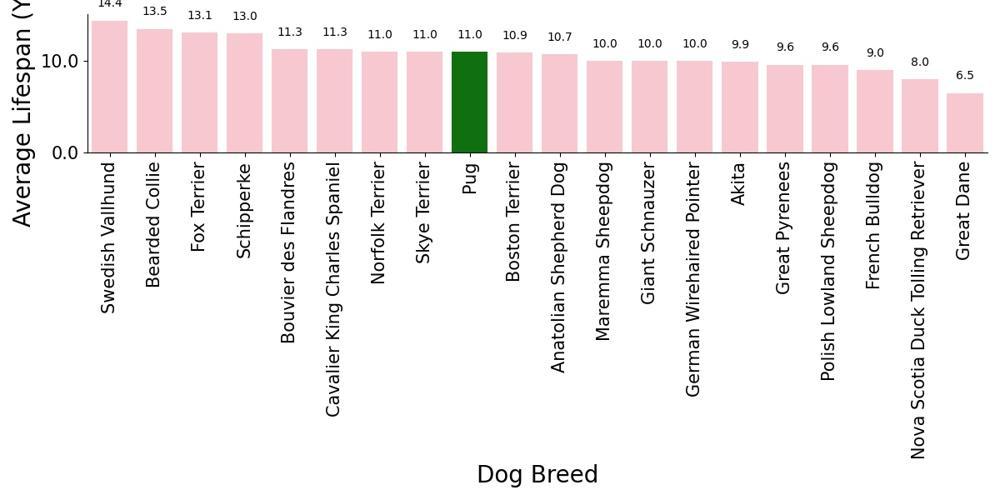
Lifespan of the Pug Compared to Other Dog Breeds
See in the table below how the lifespan of the Pug compares to the lifespan of other dog breeds.
| Dog Breed | Average Lifespan (Years) |
|---|---|
| Swedish Vallhund Lifespan | 14.40 |
| Bearded Collie Lifespan | 13.50 |
| Fox Terrier Lifespan | 13.10 |
| Schipperke Lifespan | 13.00 |
| Bouvier des Flandres Lifespan | 11.30 |
| Cavalier King Charles Spaniel Lifespan | 11.30 |
| Norfolk Terrier Lifespan | 11.00 |
| Skye Terrier Lifespan | 11.00 |
| Pug Lifespan | 11.00 |
| Boston Terrier Lifespan | 10.90 |
| Anatolian Shepherd Dog Lifespan | 10.70 |
| Maremma Sheepdog Lifespan | 10.00 |
| Giant Schnauzer Lifespan | 10.00 |
| German Wirehaired Pointer Lifespan | 10.00 |
| Akita Lifespan | 9.92 |
| Great Pyrenees Lifespan | 9.58 |
| Polish Lowland Sheepdog Lifespan | 9.58 |
| French Bulldog Lifespan | 9.00 |
| Nova Scotia Duck Tolling Retriever Lifespan | 8.00 |
| Great Dane Lifespan | 6.50 |
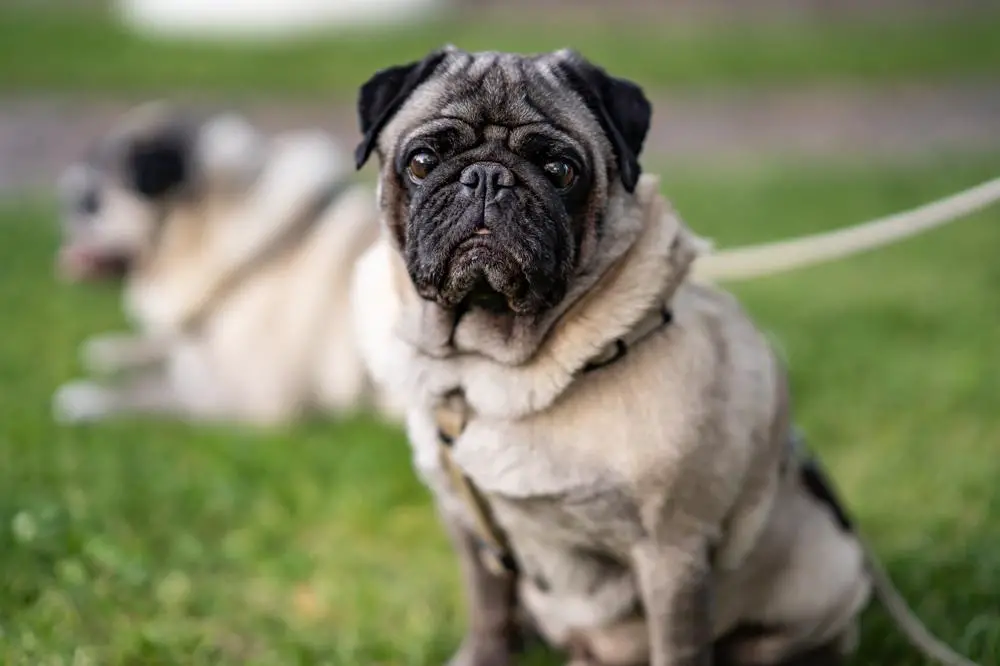
Common Causes of Death in Pug, and how to Prevent Them.
We will now discuss the common causes of death in Pug, according to scientific research. Also we will provide you advice on how to prevent these problems in your Pug.
Here are the causes of death, starting from the most common cause
-
Neurologic Disease in Pugs
These problems include canine cognitive disfunction, dementia, stroke, Lyme disease, and more.
Neurologic Disease is responsible for 27.4 percent of all deaths in Pugs.
Causes of Neurologic Disease in Pug
Neurological issues can be caused by vascular disease, inflammatory disease, infectious disease, metabolic disease, cancer, and developmental disorders.
How to Prevent Neurologic Disease in Pugs
Some neurological problems can be caused by infectious agents, like Lyme disease. You should always get your dog vaccinated with the course recommended by your veterinarian.
-
Neoplastic Disease in Pugs
Neoplasms, or tumors, can be benign (like a lipoma), or malignant (cancer).
Neoplastic Disease is responsible for 12.5 percent of all deaths in Pugs.
Causes of Neoplastic Disease in Pug
Neoplasms in dogs, just like in people, are caused by either a genetic predisposition (like some breast cancers), an environmental factor (like smoking in humans), or a combination of both.
How to Prevent Neoplastic Disease in Pugs
Just like in humans, there is little you can do to prevent cancers that are caused by genetic factors. You can, however, reduce the environmental risks that are associated with cancer. The `environmental` causes of neoplasia are chemical agents, infectious agents, and physical agents. An example of a chemical agent that could cause cancer in Pugs (and humans) is asbestos. An example of an infectious agent that could cause cancer in Pugs is the virus called canine adenovirus. An example of a physical agent that can cause cancer in Pugs is UV radiation from the sun, just like in humans.
Another way to prevent neoplasms in Pugs is to vaccinate them against harmful viruses, such as canine adenovirus (DHPP vaccine at 8 and 12 weeks and then once a year, every year). As in humans, early diagnosis is the key to supporting Pugs with neoplasms, so talk to your veterinarian if you find any new lumps, bumps, or discoloration on your Pug. You should also talk to your veterinarian if your Pug`s gums look pale.
-
Cardiovascular Disease in Pugs
Cardiac problems may include valvular and vascular disorders, which ultimately lead to the heart`s inability to pump oxygen-rich blood to tissues. Cardiac issues can be acute or chronic, and can lead to progressive heart failure or sudden death.
Cardiovascular Disease is responsible for 11.5 percent of all deaths in Pugs.
Causes of Cardiovascular Disease in Pug
Heart disease in Pugs may be caused by genetic (inherited) factors, lack of exercise, and poor diet. Heart disease can also be caused by infections such as bacteria (endocarditis, myocarditis, and more) as well as viruses, fungi, and parasites (heartworm).
How to Prevent Cardiovascular Disease in Pugs
You can prevent heart problems in your Pug by exercising your Pug regularly and feeding your Pug a good diet. Heartworm, which causes heart problems, is also very easily avoided by using preventatives. Giving your dog the following supplements can help prevent heart diseases. Here is a good supplement that can prevent heart problems in your Pug. The supplement is not only good for your Pug`s heart, but it is also good for your Pug`s overall health.
-
Infectious Disease in Pugs
There are many types of infectious diseases: bacterial, viral, parasitic, and fungal infections. Different diseases have different causes and they affect different parts of the body. For example, E. coli causes an infection in the intestines which can cause diarrhea in humans and dogs, whereas Demodex is a parasite on dog skin.
Infectious Disease is responsible for 10.9 percent of all deaths in Pugs.
Causes of Infectious Disease in Pug
All infectious agents fall into two categories: the ones that invade the body from the outside, and the ones that are living in or on the body that experience an overgrowth. For example, staphylococcus aureus is a normal bacteria found on the skin; however, it can cause skin infections if its growth gets out of hand. Both types of infectious agents can be stopped by the body`s immune response. Internal infectious agents can also be prevented by probiotics.
How to Prevent Infectious Disease in Pugs
If your Pug seems like they are not doing well, you should take them to the veterinarian so they can decide if your dog needs antibiotics, fluids, a dewormer, or other therapies. When your Pug is well, you can support their immune health through nutrition, probiotics like this and vitamins.
-
Respiratory Disease in Pugs
Respiratory diseases includes asthma, bronchitis, pneumonia, and other conditions. May also be related to left-sided heart failure and other cardiovascular issues.
Respiratory Disease is responsible for 10.0 percent of all deaths in Pugs.
Causes of Respiratory Disease in Pug
Some lung conditions can be caused by bacteria, viruses, and parasites. Other lung conditions, such as asthma, can be related to allergies and genetic conditions. Some breeds (called brachycephalic breeds) are more susceptible to breathing problems. These breeds appear to have their noses and snouts kind of squished into their faces. Although they are very cute, these breeds can have serious breathing problems throughout their lives which may require surgery. Additionally, dogs and cats can often get colds and other upper respiratory infections because of stress. Common causes of stress in dogs include separation anxiety, thunderstorms and other loud noises, the introduction of other animals into the home, and more.
How to Prevent Respiratory Disease in Pugs
Respiratory diseases can be prevented by supporting the immune health of your Pug, by making sure you feed your Pug a good, nutritious dog food brand, give them plenty of exercises, and help them live in a stress-free environment. There are several options for supplements and therapies that can help reduce stress in your Pug. Some Pug do really well with thundershirts, which are snug shirts that swaddle the dogs and help them calm down during thunderstorms and other stressful events. Furthermore, Pugs that are anxious with loud sounds might also benefit from calming supplements, such as Anxiety TFLN. For general anxiety, the supplement Composure or Composure Pro might help calm your Pug`s nervousness. Some Pugs do really well with supplements, but just like with people, supplements do not work for everyone. If you are not seeing results after a few weeks of putting your Pug on a supplement to calm anxiety, you should talk to your veterinarian about behavioral therapy and stronger medications.

How To Prevent Genetic Problems in Pugs
Every dog breed has a set of genetic problems to which it is predisposed, and the Pug is not an exception.
These disease will reduce your Pug`s qualilty of life. Also, these diseases can shorten your Pug`s lifespan.
The good news is that these diseases can be prevented in Pug offsprings by only breeding Pug that have been screened and cleared of genetic defects.
The Orthopedic Foundation for Animals (OFA) is one the organizations that keep records of which disease to which a dog breed is genetically prone.
The OFA provides breeders recommendations on which genetic diseases that breeders should screen their dog parents and puppies for.
If you want a Pug puppy that will grow up to be healthy and live long, make sure that your Pug breeder screens your puppy or your puppy`s parents for the health problems that the OFA recommends for your puppy`s breed. This will increase the chances that your puppy is free from genetic defects.
If you do not know if your Pug has been screened for genetic health problems, then your can use an at-home genetic screening kit like this one to check your Pug for genetic health problems at home. This might help you in deciding whether to get your Pug a pet health insurance.
The following are the health tests that Orthopedic Foundation for Animals (OFA) recommends that breeders should screen Pugs for:

How Old is Your Pug in Human Years
The table below shows your human years equivalent age of your Pug. This table is based on a dog-to-human age study conducted by researchers from Purdue University.
Learn more about how old your Pug is in human years here.
In 1997, researchers from Purdue University developed a method for converting a dog`s age to its human age. Their method was based on the 1953 work of the French Veterinarian, A. Lebeau that we discussed above.
Researchers from Purdue University took Lebeau`s work further by taking into account two important factors to develop a more accurate method for converting a dog`s age into its human equivalent age:
- The size of the dog: Smaller dog breeds live longer than larger breed dogs
- The lifespan of the dog: Dog breeds that live longer lives will age slower than dog breeds that live shorter lives
The average lifespan of the Pug is 11.0 years.
Pugs are small-sized dogs. Pugs weigh 14 to 18 pounds.
The method developed by the Purdue University veterinarian researchers took into account the lifespan and size of Pug in converting Pug age to human age.
The researchers used data on the lifespan and weight of 5,608 mixed breed dogs and 17,927 purebred dogs to develop their method for converting the ages of dogs (of different breed sizes and lifespans ) to their equivalent human ages.
The calculator below lets you convert your Pug`s age to its human age based on the Purdue University method. Just enter your Pug`s age in the calculator and it will compute your Pug`s human age. If you do not know your Pug`s exact age, enter an approximate age in the calculator.
Also, the table below shows how old your Pug is in human years based on the method developed by the researchers.
Note that your Pug`s human age changes day by day. Therefore, always check back to use the calculator to find your Pug`s up-to-date human age.
Pug Age to Human Age Calculator (Purdue Uni. Method)
Below is a Pug age to human age calculator that is based on the methods developed by researchers from Purdue University.
The calculator will tell your Pug`s human age based on your Pug`s dog birthday. Also, the calculator will tell you which day is your Pug`s human birthday! Try it out!
| Pug Age (Years) | Human Age (Years) |
|---|---|
| 1 | 12 |
| 2 | 19 |
| 3 | 25 |
| 4 | 30 |
| 5 | 35 |
| 6 | 40 |
| 7 | 44 |
| 8 | 48 |
| 9 | 52 |
| 10 | 56 |
| 11 | 59 |
| 12 | 63 |
| 13 | 67 |
| 14 | 71 |
| 15 | 75 |
| 16 | 79 |
How Long Do Pugs Live in Human Years?
The average lifespan of the Pug is 11.0 years. In human years, the Pug lives for 59 years.
How Old is 4-year-old Pug in Human Years?
A 4-year old Pug is 30 years old in human years.
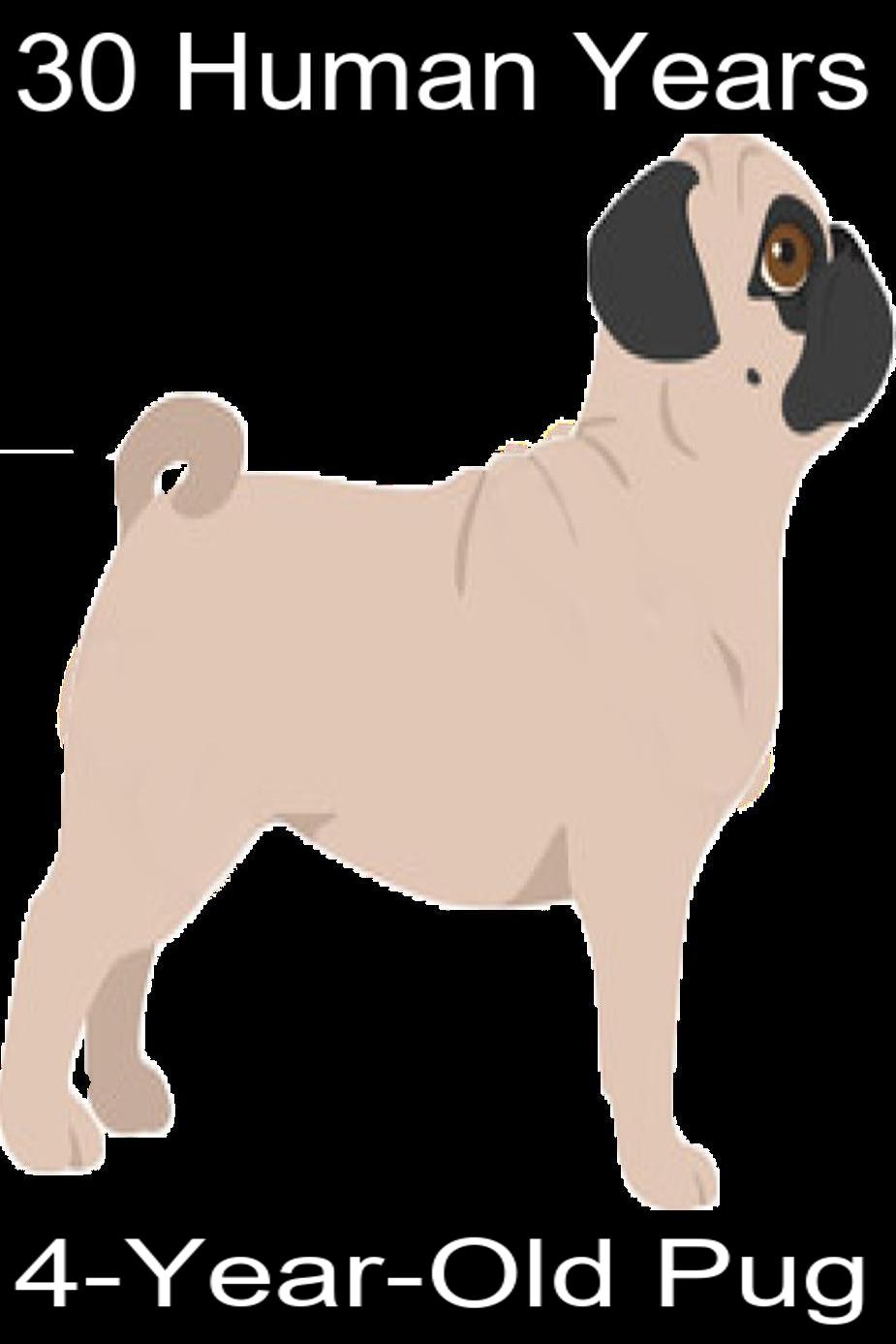
How Old is 6-year-old Pug in Human Years?
A 6-year old Pug is 40 years old in human years.
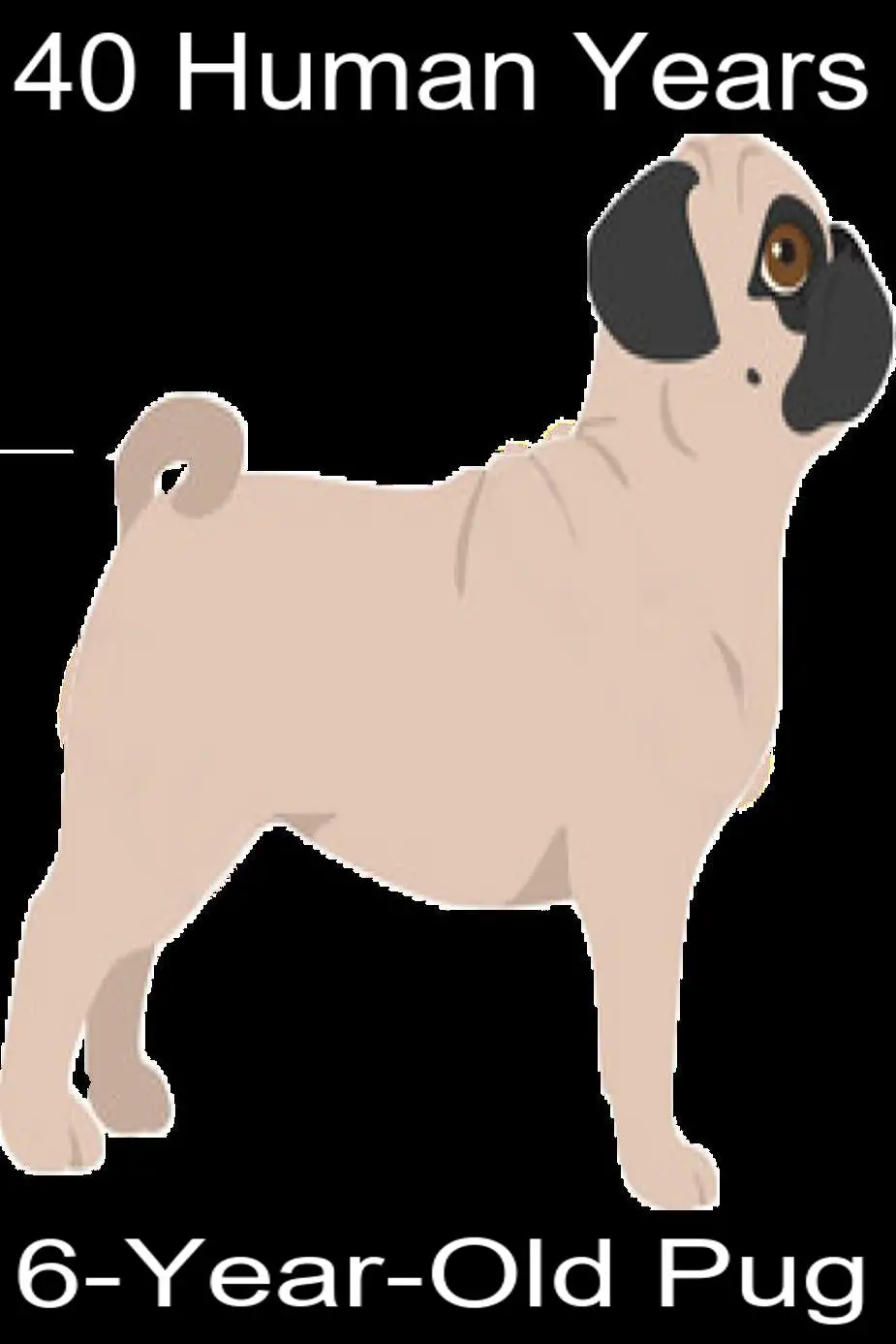
How Old is 7-year-old Pug in Human Years?
A 7-year old Pug is 44 years old in human years.
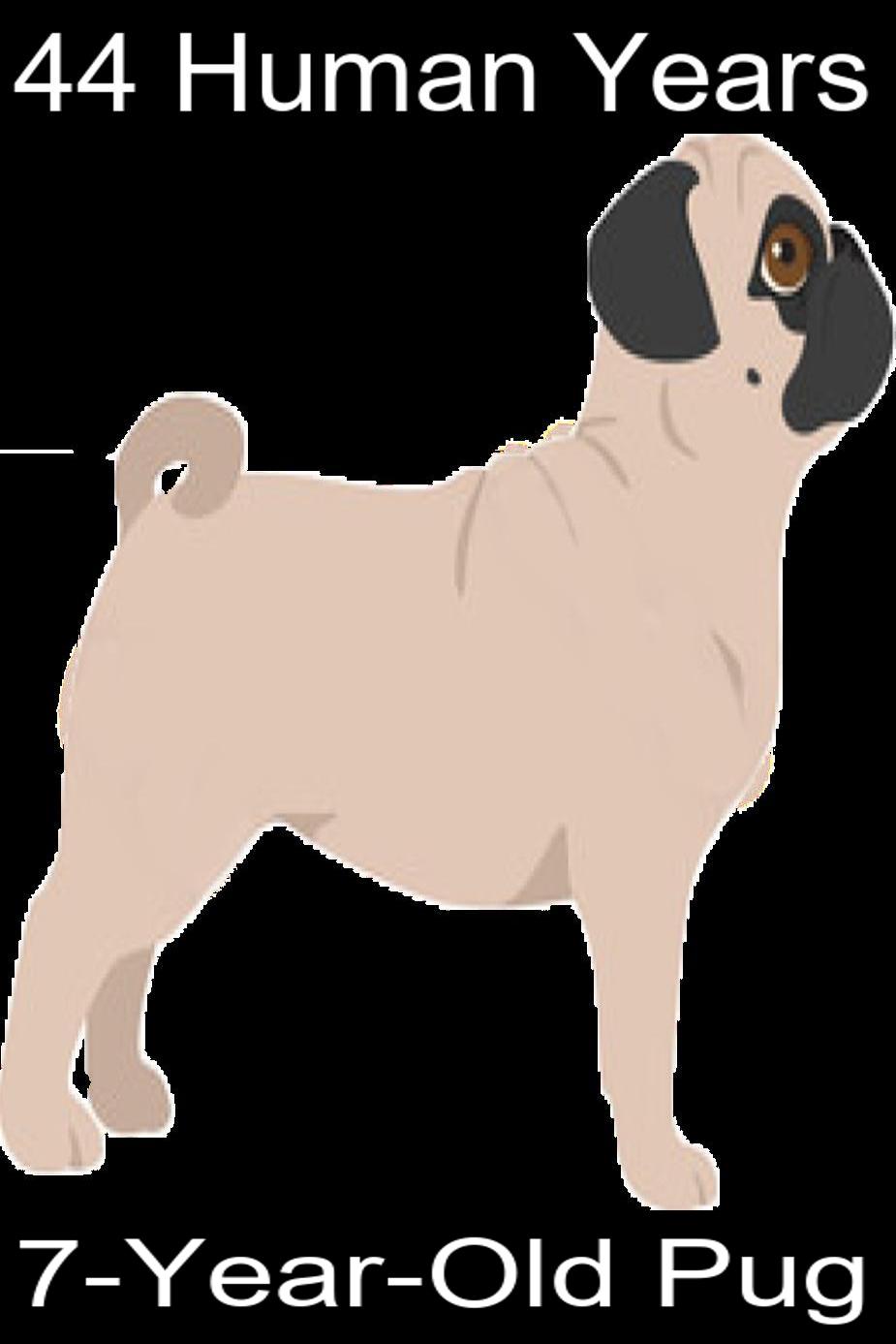
How Old is 10-year-old Pug in Human Years?
A 10-year old Pug is 56 years old in human years.
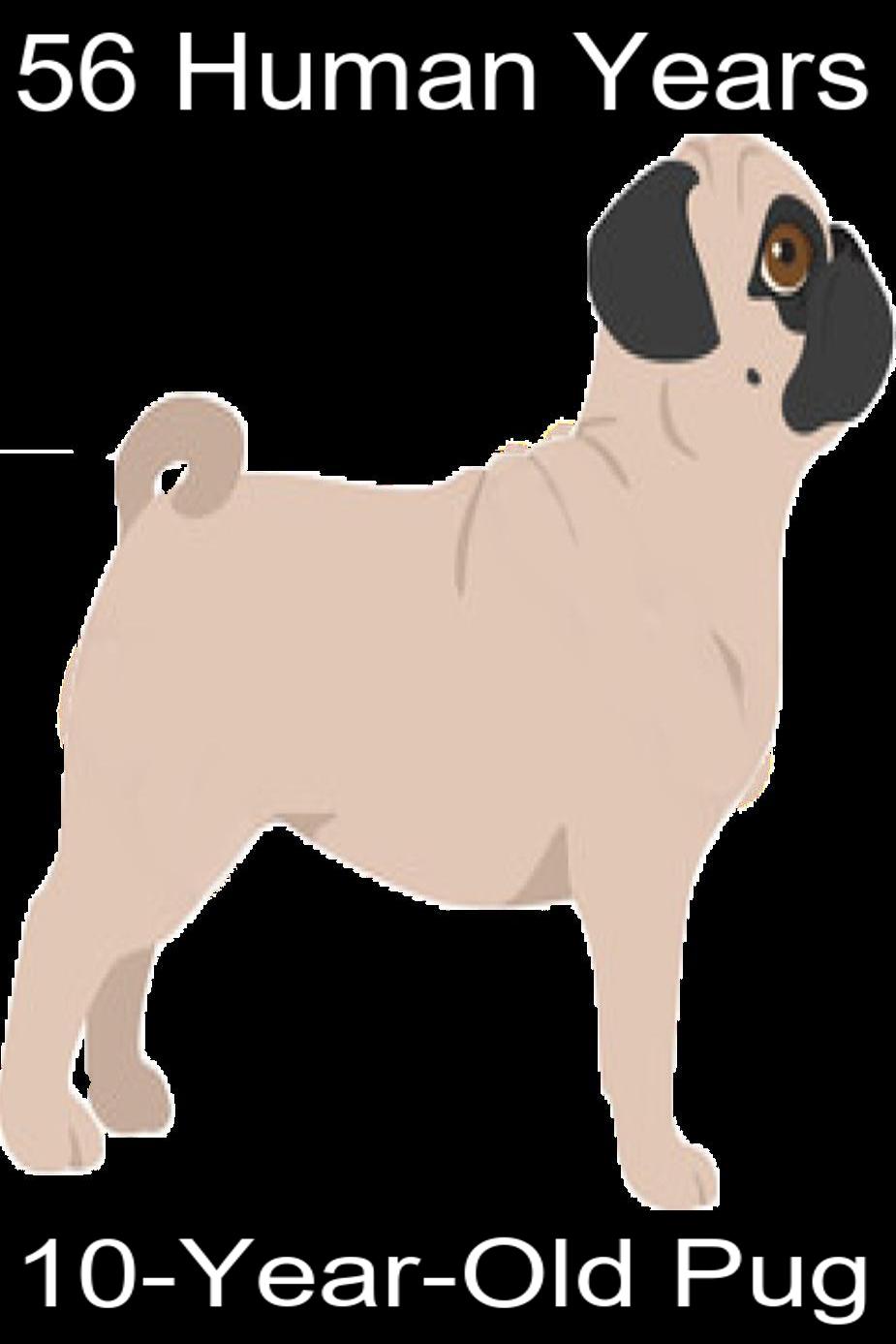
More Ways to Make Your Pug Live Long
Here are more things your can do to make sure your Pug live a long life:
-
Regular Exercise: Research studies have shown that one of the very effective ways to make a dog live long is to ensure that a dog is in good shape. Adequate exercise will make your Pug fit and make it live longer.
-
Good Diet: A poorly-fed, underweight Pug does not have a good chance of living a long life. Similarly, an overweight Pug will have a shorter lifespan than a Pug that is of normal weight. Therefore, it is important that your feed your Pug high-quality dog food without overfeeding your Pug. Check out our Pug feeding guide here. Learn how you can prevent your Pug from being overweight here.
-
Proper Hydration: Water is essential for your Pug existence. Therefore, you should make sure your Pug has access to clean water whenever your Pug needs water. However, too much water is bad for your Pug. See our Pug water drinking guide to learn more on how to properly hydrate your Pug.
-
Spaying/Neutering: Sterilizing your Pug might prolong its life. Check out this guideline to know when it is the best time to spay/neuter your Pug.
-
Routine Vet Care: Regular preventative visits to the vet can help catch diseases early.
-
Vaccinations: Always make sure your Pug is up to date on its vaccination.
-
Dental Hygiene: Your Pug’s teeth can get infected, and if the infection goes unnoticed, that infection can spread to other parts of the body and become systemic. This could lead to a shortened lifespan. You must have your Pug teeth cleaned professionally at your vet’s office a couple of times in its lifetime. Talk with your vet about the best ages to have these cleanings done.
Conclusion on Pug Life Expectancy
We hope the information we have provided will help your in increasing your Pug`s life expectancy.
Tate Ackerman contributed to this article. Tate is a second-year veterinary student at Kansas State University. Tate is also a concurrent Ph.D. student. She has a lot of experience reading scientific literature and communicating that information to a non-veterinary audience. Tate was a veterinary technician for a companion animal practice before she applied to veterinary school.